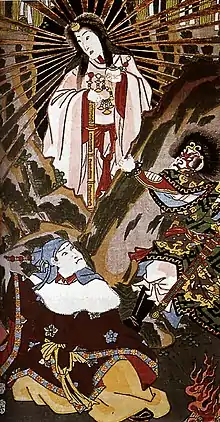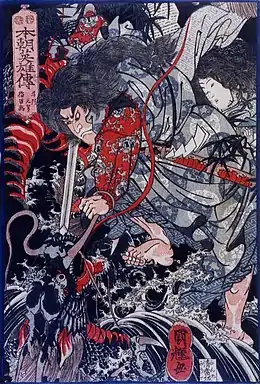Kagu-tsuchi
Kagutsuchi (カグツチ; Old Japanese: Kagututi), also known as Hi-no-Kagutsuchi or Homusubi among other names, is the kami of fire in classical Japanese mythology.[1]
| Hi-no-Kagutsuchi-no-Kami | |
|---|---|
| Other names | Kagutsuchi-no-Mikoto (軻遇突智命, 加具土命) Homusubi (火産霊) Hi-no-Yagihayao-no-Kami (火之夜藝速男神) Hi-no-Yakihayao-no-Mikoto-no-Kami (火焼速男命神) Hi-no-Yakihiko-no-Kami (火焼彦神) Ho-no-Yakezumi-no-Kami (火焼炭神) |
| Japanese | 火之迦具土神 |
| Major cult center | Honoo-Honome Shrine, Ubuta Shrine, Hananoiwaya Shrine, Akiha Shrine, and others |
| Gender | Male |
| Parents | Izanagi (father) Izanami (mother) |
| Offspring | Nesaku, Takemikazuchi, Kuraokami and others |
Mythology
Kagutsuchi's birth burned his mother Izanami, causing her death. His father Izanagi, in his grief, beheaded Kagutsuchi with his sword, Ame no Ohabari (天之尾羽張), and cut his body into eight pieces, which became eight volcanoes. Kagutsuchi's corpse created numerous deities, which typically includes Watatsumi, Kuraokami, Takemikazuchi, Futsunushi, Amatsumikaboshi, and Ōyamatsumi.[2][3]
Kagutsuchi's birth, in Japanese mythology, comes at the end of the creation of the world and marks the beginning of death.[4] In the Engishiki, a source which contains the myth, Izanami, in her death throes, bears the water god Mizuhanome, instructing her to pacify Kagu-tsuchi if he should become violent. This story also contains references to traditional fire-fighting tools: gourds for carrying water and wet clay and water reeds for smothering fires.[4]
Name
The name Kagutsuchi was originally a compound phrase, consisting of kagu, an Old Japanese root verb meaning "to shine"; tsu, the Old Japanese possessive particle; and chi, an Old Japanese root meaning "force, power".[5]
Worship
Kagutsuchi is the patron deity of blacksmiths and ceramic workers. He is worshipped in several shrines, one of which is Atago Shrine, near Kyoto.[6]
Popular culture
- In the manga and anime Sailor Moon, a character named Hino Rei uses flame magic.
- In the manga and anime Fairy Tail, a character named Zancrow uses the Flame God Slayer Magic and has an attack named after Kagutsuchi.
- In the manga Noragami, Kagutsuchi appears during the subjugation of Bishamon and is shown to be capable of blowing fire.
- In the anime Mai-HiME, Mai's Child is based upon Kagutsuchi.
- In the manga and anime Naruto: Shippuden, one of the main characters, Sasuke Uchiha, is shown to have the ability to manipulate the black flames of Amaterasu into various weapons. This is referred to as Blaze Release: Kagutsuchi, which refers to the fire god.
- In the anime Ao No Exorcist, the hometown to several of the characters is Kyoto, where a powerful sword was made from long ago by, and had to do with Kagu-Tsuchi.
- In the video game series BlazBlue, the main setting of the first two games is the 13th Hierarchical City of Kagutsuchi.
- In the same video game series, one of the playable characters, Nine the Phantom, has Hi no Kagutsuchi, an enormous fire elemental that can be summoned by her.
- In the video game series Brave Frontier, Kagatsuchi is a fire-based battle unit. He's in the form of a centaur, and is described as "a disastrous beast".
- In the manga Rurouni Kenshin, the main antagonist of the Kyoto Arc, Shishio Makoto, uses a technique called "The Final Secret Sword: Kagutsuchi" as a last resort "trump card", bringing down a cyclone of flames that his sword can produce at his enemy.
- In the Shin Megami Tensei and Persona franchises, Kagutsuchi is a recurring figure in various titles. In some he is a regular demon to be recruited, a sword bearing his name in reference to the novels the franchises are based on, and in others he is a central figure to the plot.
- In the video game Call of Duty: Black Ops II, a fire-elemental staff known as "Kagutsuchi's Blood" can be obtained on the Zombies map "Origins".
- In the mobile phone game Puzzle and Dragons, developed by Gung-ho, Hino Kagutsuchi is a collectible fire monster.
- In the card game Yu-Gi-Oh!, alongside Susanoo, Amaterasu, and Tsukuyomi, Kagutsuchi is one of the 4 Xyz Monsters of Bujin.
- In the mobile game Monster Strike, Kagutsuchi is a fire collectible, along with Susano'o, Amaterasu, Inari, Izanami, Izanagi and more.
- In the mobile game Dragalia Lost, Kagutsuchi appears as a red Flame-type dragon with golden armor fused to his body, given the title of 'Incandescent General'. He is described as the rival of the game's similarly-dragonized version of Marishi-Ten, with the two of them inadvertently creating a magical hot spring in the Hogo region of Hinomoto, the game's version of Japan, during one of their duels, when Marishiten caused Kagutsuchi's molten blood to seep into the spring's water, permanently heating it and leading the locals to dub it the Bloodspring or Twin-Wyrm Spring in honor of the dragons' eventual friendship. When Kagutsuchi isn't waging war, he's usually basking in a hot spring or frying chicken, which he offers to his allies.
- In the manga and anime Gintama, the main weapon aboard the Altana Liberation Army's flag ship Amenotorifune, intended to destroy the Earth, is called "Hinokagutsuchi".
- In the video game Ghost of Tsushima, there is a Charm of Kagu-Tsuchi. This charm is granted by finding and honoring the Plum Blossom Shrine.
- In the light novel High School DxD: Slash/Dog series, Kagu-tsuchi is the Shinto God of Fire and also the patron deity of the Himejima Clan whom in turned blessed them with the power of spiritual flames. A descendant of the Himejima, Tobio Ikuse is the wielder of the Ame no Ohabari, the divine sword which killed Kagu-tsuchi which is infused with Kagu-tsuchi's divine flames which grant it immense power to kill even a Demon Lord Gressil.
- In the video game series The Alchemist Code, the royal family of Wadatsumi, Rising Ashes, which consists of Mitsuha, Kagura, Zeke Crowley and Logi Crowley, uses a fire ability called Kagutsuchi, which takes the form of a phoenix when used. This technique is very powerful against a type of enemy, ogres. In difficult situations, Mitsuha, Kagura and Logi use an advanced form of the fire technique, called "Kagutsuchi Kiraboshi".
Family tree
| Susanoo[7][8] | Ōyamatsumi[9] | ||||||||||||||||||||||||||||||||||||||||||
| Ashinazuchi[10] | Tenazuchi | Konohanachiruhime[11] | |||||||||||||||||||||||||||||||||||||||||
| Kushinadahime[12] | |||||||||||||||||||||||||||||||||||||||||||
| Yashimajinumi[11] | |||||||||||||||||||||||||||||||||||||||||||
| Kagutsuchi[13] | |||||||||||||||||||||||||||||||||||||||||||
| Kuraokami[14] | |||||||||||||||||||||||||||||||||||||||||||
| Hikawahime[15] | Fuha-no-Mojikunusunu[16] | ||||||||||||||||||||||||||||||||||||||||||
| Fukabuchi-no-Mizuyarehana | Ame-no-Tsudoechine | Funozuno | |||||||||||||||||||||||||||||||||||||||||
| Sashikuni Okami | Omizunu | Futemimi | |||||||||||||||||||||||||||||||||||||||||
| Sashikuni Wakahime | Ame-no-Fuyukinu[17][18] | Takamimusubi | |||||||||||||||||||||||||||||||||||||||||
| Futodama | |||||||||||||||||||||||||||||||||||||||||||
| Nunakawahime | Ōkuninushi[19] (Ōnamuchi)[20] | Kamotaketsunumi no Mikoto | |||||||||||||||||||||||||||||||||||||||||
| Kotoshironushi[21] | Tamakushi-hime | Takeminakata | Susa Clan[22] | ||||||||||||||||||||||||||||||||||||||||
| JAPANESE EMPERORS | |||||||||||||||||||||||||||||||||||||||||||
| 711–585 BC Jimmu 660–585 BC(1) | Himetataraisuzu-hime[23] | Kamo no Okimi | |||||||||||||||||||||||||||||||||||||||||
| 632–549 BC Suizei 581–549 BC(2) | Isuzuyori-hime | Hikoyai | Kamuyaimimi d.577 BC | Miwa clan and Kamo clan | Nunasokonakatsu-hime | ||||||||||||||||||||||||||||||||||||||
- Pink is female.
- Blue is male.
- Grey means other or unknown.
- Clans, families, people groups are in green.
See also
- Kōjin
- Takemikazuchi
- Akiha Gongen
- List of fire gods
- Musuhi part of the tymology of Homusubi
Notes
- "Encyclopedia of Shinto - Home : Kami in Classic Texts : Kagutsuchi". eos.kokugakuin.ac.jp. Retrieved 2020-12-16.
- worldhistory.org
- "Encyclopedia of Shinto - Home : Kami in Classic Texts : Ōyamatsumi". eos.kokugakuin.ac.jp. Retrieved 2021-08-22.
- Ashkenazy, Michael. Handbook of Japanese Mythology. Santa Barbara, California: ABC-Clio, 2003. 186
- Kokugo Dai Jiten, Revised Edition (国語大辞典(新装版)) (in Japanese), Tōkyō: Shogakukan, 1988
- "Kagutsuchi, Japanese Fire God, The Fiery God of Purification by Flame". God Checker.com. Retrieved 27 August 2016.
- Atsushi, Kadoya (10 May 2005). "Susanoo". Encyclopedia of Shinto. Retrieved 2010-09-29.
- "Susanoo | Description & Mythology". Encyclopedia Britannica.
- Kaoru, Nakayama (7 May 2005). "Ōyamatsumi". Encyclopedia of Shinto. Retrieved 2010-09-29.
- Fr?d?ric, L.; Louis-Frédéric; Roth, K. (2005). Japan Encyclopedia. Harvard University Press reference library. Belknap Press of Harvard University Press. ISBN 978-0-674-01753-5. Retrieved 2020-11-21.
- "Encyclopedia of Shinto - Home : Kami in Classic Texts : Yashimajinumi". eos.kokugakuin.ac.jp.
- "Encyclopedia of Shinto - Home : Kami in Classic Texts : Kushinadahime". eos.kokugakuin.ac.jp.
- "Kagutsuchi". World History Encyclopedia.
- Ashkenazi, M. (2003). Handbook of Japanese Mythology. Handbooks of world mythology. ABC-CLIO. p. 213. ISBN 978-1-57607-467-1. Retrieved 2020-11-21.
- Chamberlain, B.H. (2012). Kojiki: Records of Ancient Matters. Tuttle Classics. Tuttle Publishing. ISBN 978-1-4629-0511-9. Retrieved 2020-11-21.
- Herbert, J. (2010). Shinto: At the Fountainhead of Japan. Routledge Library Editions: Japan. Taylor & Francis. p. 402. ISBN 978-1-136-90376-2. Retrieved 2020-11-21.
- Philippi, Donald L. (2015). Kojiki. Princeton University Press. p. 92.
- Chamberlain (1882). Section XX.—The August Ancestors of the Deity-Master-Of-The-Great Land.
- Atsushi, Kadoya; Tatsuya, Yumiyama (20 October 2005). "Ōkuninushi". Encyclopedia of Shinto. Retrieved 2010-09-29.
- Atsushi, Kadoya (21 April 2005). "Ōnamuchi". Encyclopedia of Shinto. Retrieved 2010-09-29.
- Atsushi, Kadoya (28 April 2005). "Kotoshironushi". Encyclopedia of Shinto. Retrieved 2010-09-29.
- Tanigawa Ken'ichi 『日本の神々 神社と聖地 7 山陰』(新装復刊) 2000年 白水社 ISBN 978-4-560-02507-9
- Kazuhiko, Nishioka (26 April 2005). "Isukeyorihime". Encyclopedia of Shinto. Retrieved 2010-09-29.
References
- Ashkenazy, Michael. Handbook of Japanese Mythology. Santa Barbara, California: ABC-Clio, 2003.
- Bock, Felicia G., trans. Engi-shiki: Procedures of the Engi Era. ASU Center for Asian Studies (Occasional Paper #17).
External links
- Kagutsuchi, Encyclopedia of Shinto
- Kagutsuchi on the Japanese History Database.

